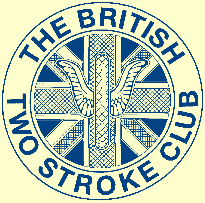
As the 1940s gave way to the 1950s there was a great demand for personal transport in a Europe which was suffering from post-war austerity. Motor cycle manufacturers were struggling with limited supplies of raw materials to manufacture a range of motor cycles which mostly had to be exported in order to build up national currency reserves. So new machines were not readily available to home buyers, even if they could afford the purchase price. An enterprising young Italian bolted a small engine to his cycle and, driving the machine along by a friction roller to the rear tyre, he went touring on it. I believe that this was the basis for the Mini-Motor, manufactured by the Trojan concern of Croydon.
The idea was taken up enthusiastically and soon many manufacturers throughout Europe were manufacturing similar cycle propulsion units. These units were either fitted over the rear wheel where a carrier would normally be, over the front wheel, under the bottom bracket, or in the rear wheel. They very soon came to be called "Clip-ons" or "Cyclemotors". Costing around 25 to about 30 pounds in Britain, they could be bolted to virtually any full size cycle of substantial construction and once registration details had been sorted out, away you could ride, with freedom from most of the exertions of pedalling.
By 1952 sales of cyclemotors throughout Europe was booming and in Britain several clubs were formed by enthusiasts who wished to obtain more out of their machines than just riding them to and from work. The President of the British Two Stroke Club at that time was Professor A M Low, who was also a prominent figure within the Auto Cycle Union, the governing body for matters motor cycling. Professor Low had a great enthusiasm for the small two-stroke power unit as a useful and economical personal transport solution and the cyclemotor seemed to fit these ideals perfectly. So, to further promote these cyclemotors and to see how the various units performed, the ACU decided to run a short competition and road trial for cyclemotors. It was to be run on behalf of the ACU by the British Two Stroke Club and would take place at Wembley Stadium on the day after the Football Association cup final.
As the day started the weather was not very promising, with heavy clouds threatening rain. Unfortunately, although the rain held off until the later stages, it then came down heavily, which upset the performance of some competitors, especially those without hub brakes and those with roller friction drive motors. Nevertheless, despite the threatening conditions sixty competitors made the effort to take part in the trials. The most numerous of the machines taking part were Berini, with 11 representatives, followed by Cyclemaster with 9, Power Pak with 8, Mini-Motor with 7, Mocyc with 4, Cyclaid, Mosquito and Ducati Cucciolo with 3, Bantamoto, VAP, Miller and VéloSoleX with 2 and a single example of a Dutch Jet, ridden by the manufacturer's son.
Also prototypes of the newly designed Tailwind, with a double diameter friction roller, giving a second gear were taking part, one of these was ridden by its designer J Latta.
The trial consisted of a 20 mile road section to the north of London which had to be covered at an average speed of 12mph, those arriving early were excluded whilst a penalty of one mark was awarded for each minute that a competitor arrived later than three minutes past their signing on time. The course included an observed test hill where penalties were awarded for the amount of pedal assistance required. These penalties were on a sliding scale up to a maximum of 25 for a complete stop. At the end of the course the competitors were subjected to a braking test and an exhaust noise measurement test carried out with Professor Low's Audiometer. This was something which might be thought common place these days with stringent noise limits, but was almost unheard of in 1952.
In the competition itself only two retirements occurred out of the sixty starters, but six riders were excluded for early arrival, which seemed a bit harsh to me as I would have thought that penalty points such as those for lateness would have been more appropriate. I know that the intention would normally be to prevent illegal speeding, but not on these machines surely. On the test hill the two speed Ducatis and Tailwinds did well, as expected. However, not all the single speed units needed pedal assistance and in particular the Cyclaids, despite being of only 3lcc did very well as did one of the Millers. Examples of Mosquito, Mini-Motor, VAP and Power Pak also made unassisted climbs, but others of the same marques did not. Obviously the riders personal weight, as well as that of his cycle had a bearing on this, with only minimal engine power available. Only two retirements shows that all these little engines were easily capable of reliable use and at the end of the competition first class awards were taken by the riders of Power Pak, Cyclemaster, Cyclaid, Tailwind, Miller, Mosquito, Minimotor, Ducati and Bantamoto, which is quite a cross section of the makes taking part. To win a first class award a competitor had to lose no more than 10 marks, so these competitors and their machines turned in very creditable performances.
For the following year the competition was repeated in much the same format. However it would appear that the competition was dropped by the ACU for 1954 as the entire event was run this year by the British Two Stroke Club only and centred this time on Catford in South London, finishing at the Greyhound Stadium.
By this time the boom period for cyclemotors had passed, as with post war production of new motor cycles for the home market now in full swing there were lots of good secondhand bikes around for a similar price to a new cyclemotor. Also purpose designed mopeds were now coming onto the market in increasing numbers, destined to replace both cyclemotors and the larger 98cc autocycles eventually.
The wane in popularity of the cyclemotor had not yet really begun to show on the roads, but was reflected to some extent by the comparatively low turn out for the 1954 event of 36 from 39 actual entries. Although both the weekly motor cycle magazines gave a write-up to the event (which perhaps reflected more the status of Professor Low than the importance of the event itself) they were markedly less enthusiastic about the 1954 event than they were in 1952, with Motor Cycling calling it a "Pleasant but frankly insignificant event". One innovation this year though was the controllability test (ie: riding between obstructions) at the end of the trial. Also the road mileage had been increased to around 30 miles, to be ridden at an average speed of 15mph.
Although entries were down the enthusiasm of the competitors was as high as ever, with several specials taking part. One rider (a Mr D Widmer) riding a 50cc Busy Bee, which he had built himself. Another (Mr J Stracey) having mounted a Mini-Motor engine in the middle of his cycle frame with his own designed drive to the chain wheel and Mr W H Griffin coffipleting the whole course with a pillion passenger on his Cyclemaster. The prototype Tailwind which gained a 1st in 1952 again took part, this time ridden by someone else (it never did get into production) and it again acquitted itself well.
There were two makes taking part this year which had not appeared in 1952, presumably because they were not around at that time. These were the Itom and the Vincent Firefly. However neither of these figured in the first class award list. I was surprised to see that there was no mention of the BSA Winged Wheel or the Teagle among the entries. However these were very late models to the range of available cyclemotors so maybe they had not really made a presence by that time.
Although those who competed in the event obviously enjoyed it, the main reason for its being in the first place (ie: publicising the capabilities of these small machines) was no longer really relevant with the appearance of what we now recognise as traditional mopeds, which offered greater comfort, performance, braking and lighting. Consequently, although many enthusiasts such as our own Ray Pratley and Les Jones went on, in subsequent years, to cover great mileages on cyclemotors in events such as the ACU National Rally, it was decided that the Cyclemotor Demonstration Trial had served its purpose but now had its day.
This article was first published in the January/February 2000 edition of 'The Independent', the magazine of the British Two Stroke Club. At that time, Colin Atkinson was the BTSC's President.
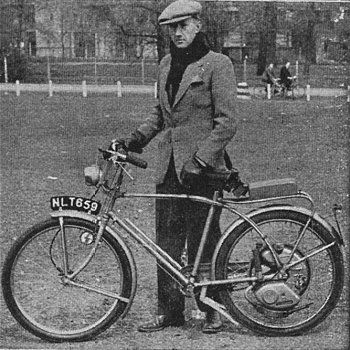
W H Griffin took part on this Mercury framed Cyclemaster with a pillion seat.
Although he rode the machine solo in 1953, he entered the same machine in the 1954 Motor Assisted Cycle Demonstration Trial and, that time, carried a pillion passenger throughout the Trial.
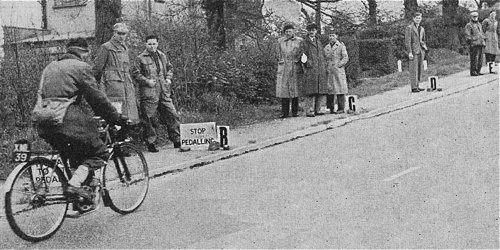
A Ducati Cucciolo at one of the two hill climbing tests.
No fewer that 16 Cucciolos took part in 1953, more than any other make of cyclemotor.
The documentation issued to participants in the 1953 ACU/BTSC MACDT is also reproduced in this Archive
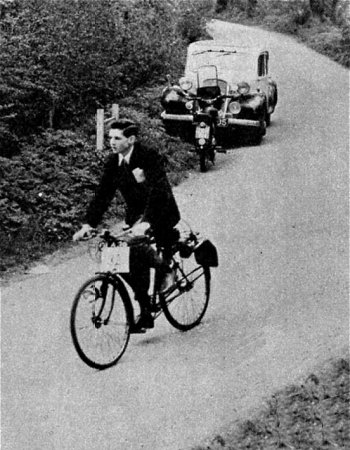
The Busy Bee being ridden by D Widmer.
This hill was used as the brake test section of the 1954 Motor Assisted Cycle Demonstration Trial.
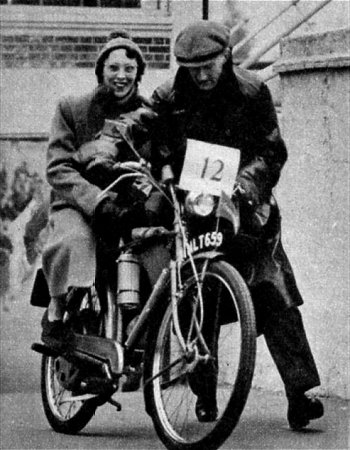
W H Griffin took a pillion passenger on his Cyclemaster thoughout the Trial.
The cycle is a Mercury and was a purpose-built pillion frame produced with the official sanction of Cyclemaster.
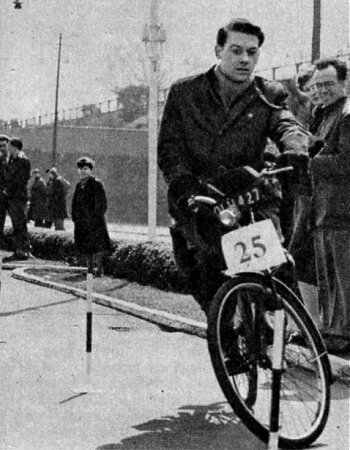
W L Manley riding a Sinclair-Goddard Power Pak.
He is pictured weaving through a series of posts. This "controllability test" was introduced in the 1954 trial.